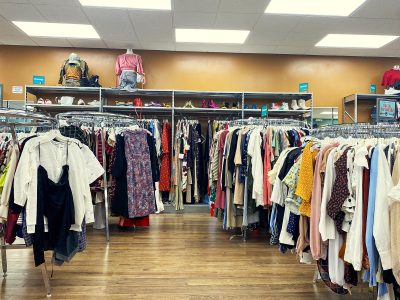Whether it be picking up vintage fashion items or recycling personal goods, thrifting in Boston is a community-oriented activity for people of all backgrounds. Both thrift store managers and student shoppers said thrifting is more popular today than ever before. In total, the resale market is predicted to reach $64 billion by 2024, according to research by Thredup.

“I think the business is growing,” said Kenza Trabelsi, the assistant manager at the Goodwill located at 965 Commonwealth Ave. “It’s much better than it used to be.”
Trabelsi said the rise of student participation in shopping at thrift stores, especially on weekends, has been positive for business. Although more students are shopping over the weekends, she added regular customers are still showing up daily.
With increasing youth involvement, Trabelsi expressed optimism in the future of the thrifting industry.
“We have a bright future, very good,” she said. “The minimum wage went up, which is good for our employees, and we get very good merchandise, we have good people.”
Trabelsi said the store contains rare gems to suit students’ ever-changing style at relatively inexpensive prices — ranging from about 99 cents to $10 — which makes shopping more accessible.
“If you go to a regular store, you cannot find the same stuff at Goodwill,” she said. “People are very trendy, they like baggy pants, big blazers, men’s blazers, shirts, everything changes, you know, from two years ago.”
Boomerangs, a thrift store franchise, is owned and operated by Fenway Health’s AIDS Action — the region’s most prominent provider of HIV wellness and prevention services — and all proceeds go to help people with HIV and AIDS and prevent new infection, as well as support the LGBTQ+ community.
Jill Martin, the store manager of Boomerangs in Jamaica Plain, said despite busy hours, the thrift store’s cause-driven nature makes the work rewarding.
“Even when it’s busy, when it’s tough work, it’s all going somewhere good at the end of the day,” Martin said, “and I think that a lot of people like supporting us because of that cause.”
Boomerangs is located in both Jamaica Plain and Central Square in Cambridge, along with a special edition store in the South End.
In addition to the specific charitable focus of Boomerangs, Martin said thrifting in general has environmental benefits by eliminating waste.
Martin said the fast-fashion industry — where clothes are mass-produced and sold at low costs — can create “a strain on the environment,” but thrifting can help mitigate its harms on the environment.
“There’s so much water used and waste involved in that,” she said. “It’s good to have thrift stores and places that are recycling.”
Tiana Gallagher, a sophomore in the College of Arts and Sciences, said it is important for young people to understand the environmental advantages of buying and selling second-hand clothing.
“The slow fashion cycle that’s brought on by thrifting is very much beneficial for the environment,” Gallagher said. “Especially for young people, I feel like we’re very consumerist nowadays, so it’s good to slow things down.”
Gallagher said she enjoys thrifting not only because of its contribution to sustainability but also because of the gratifying feeling of finding a personal item among all the recycled products.
“It’s fun,” Gallagher said. “For thrifting, when you find something that you like, there’s more gratification.”
While Gallagher enjoys thrift stores, she said people buying items to sell them at a higher price on platforms such as Depop can be problematic.
“I have a big problem with people reselling stuff, just because I think it’s basically clothing gentrification,” Gallagher said. “You should be buying clothes to wear them, that’s the point of clothes. You shouldn’t be buying things just to upsell them.”
Martin said she feels as though more people are becoming aware of the damage of the fast-fashion industry recently, which could explain the uptick of people shopping.
“People are more aware of that now that that’s a better option to get stuff thrifted, and you can find better things that are well-made,” she said. “The vintage clothes section’s always amazing, you can get really cool items in there from even decades ago.”
Nonetheless, for people like Martin, the benefits of thrifting remain clear.
“In the years that I’ve worked here, I’ve learned so much about everything: about clothes, about antiques, about brands and art,” she said. “We’ve seen so much come through here and there’s some really cool stuff.”
Martin said working at Boomerangs for about six years has made her realize “the value of giving back” to others.
“Thrifting is definitely here to stay,” she said.



























































































































Olivia Hammond • Apr 29, 2021 at 2:45 pm
Wow, so interesting. I love how you talked about the “clothing gentrification” of reselling thrifted clothes on depop. On the app, people love to tag their products as “thrifted” or “upcycled,” but it’s pretty clear that they’re selling the clothes for way more than they would ever be at a normal thrift store. Thanks for touching on this in such an interesting and well-written way!